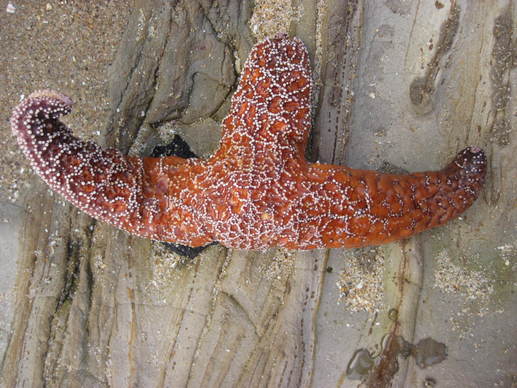Sea Star Wasting Syndrome Reaches Santa Barbara County
Mysterious Illness Quickly Turns Shoreline Creatures into Sludge

During an ocean dive Thursday morning off the coast of Santa Cruz, Pete Raimondi watched two halves of a broken sea star ravaged by a “wasting syndrome” walk away from each other. Not long after, they would turn into mushy piles of goo, disintegrated by a disease that has so far perplexed scientists.
Raimondi, a UCSC ecology professor, first spotted sea stars wasting away near the remote Alaskan island of Sitka this summer. Now, after months of collecting data and tracking the disease’s spread, it appears the syndrome is impacting as many as 10 sea star species up and down the West Coast, wiping out entire populations in certain areas and threatening to upset the balance of delicate intertidal ecosystems. On September 25, an affected giant sea star was found at Goleta Beach; on October 2, a sick pink sea star was discovered near More Mesa Beach.
So far, biologists haven’t been able to pinpoint the disease’s trigger, unsure whether it’s caused by a virus, bacterial infection, environmental factors, or some combination thereof. While Raimondi, his team, and a group of UCLA scientists are in the middle of a massive effort to map where the disease has established shoreline footholds, researchers at Brown and Western Washington universities are studying its pathology and root cause.
The disease typically starts as lesions on the animals’ bodies followed by the decay of surrounding tissue. While sturdier sea stars may be able to survive for days before they become deflated and eventually break apart, some are dessicated in a short period of time. “They can go from great to pieces in 12 hours,” said Raimondi. Sea stars are normally able to grow new limbs, but with the wasting syndrome, the wounds don’t heal and creep into the animals’ vital areas.
Raimondi said members of his group recently visited beaches in San Luis Obispo and found every one of the seven observed sites infected. They plan to do a comprehensive search throughout Santa Barbara County in the next two weeks.
This year’s outbreak is not the first for the West Coast. In 1983, there was a major die-off in Southern California that virtually erased ochre sea stars from tide pools. There was another die-off in 1997, but on a smaller scale. At the time, scientists theorized that the wasting syndrome was catalyzed by the warm waters of those two El Niño years: Sea stars prefer cooler waters, explained Raimondi, so warm temperatures can negatively impact their health and lead to infected wounds. Plus, bacteria proliferate and spread better in higher temperatures. But right now, the Pacific Ocean is in the middle of a cooling trend, so biologists are at a loss to explain the outbreak.
Raimondi is quick to point out that the full extent of the die-offs remains to be determined and that the impact probably won’t reach disaster levels. “We’re not talking about the loss of a species,” he said. “They’ll come back.” But there’s real worry, Raimondi went on, about disruptions in the food chain if sea stars are suddenly eliminated from intertidal areas. “Sea stars are voracious predators” he said, explaining ochre sea stars eat mussels and keep their numbers thinned so other species can attach to the rocks on which they live.


